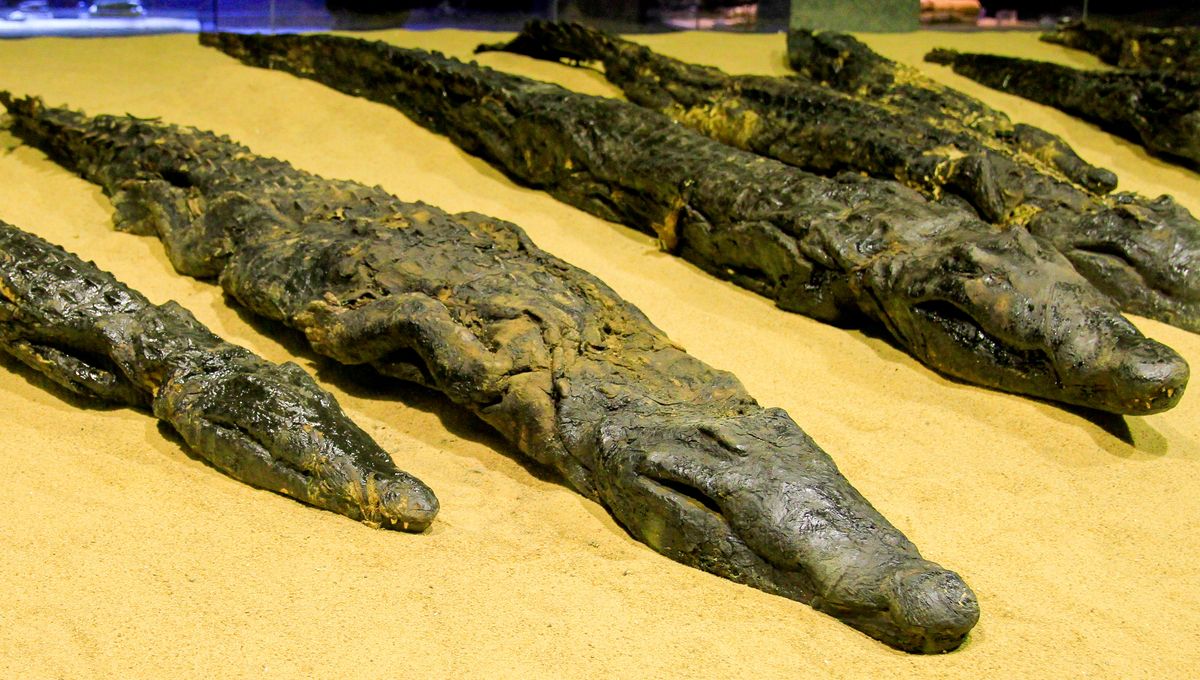
Life was a wild ride for crocodiles in Ancient Egypt. As the Nile’s most iconic predator, the scaly beasts were the focus of a bizarre cult that saw them worshiped, spoiled rotten, and sacrificed, although it has taken thousands of years for researchers to figure out how the revered reptiles were lured from their natural habitat.
The mystery of this ancient religious practice has now finally been solved thanks to a new analysis of a mummified Egyptian crocodile that had been sitting in a museum in the UK. A series of scans revealed the presence of a fish hook alongside an undigested fish inside the creature’s belly, indicating that the croc was wild-caught and killed almost immediately after being captured.
“The ancient Egyptians venerated crocodiles as avatars of Sobek, Lord of the Nile and of the primeval swamp from which they believed the Earth was created,” write the authors of a new study describing the mummified animal. They go on to explain that “centers of sacred activity dedicated to the crocodile” have been discovered throughout Egypt, evidenced by the presence of huge numbers of mummified crocs, some up to 6 meters (19.7 feet) long.
However, while countless crocodiles appear to have been sacrificed, some were also apparently pampered as “cult animals”, who were allowed to die a natural death. The most famous of these was named Suchus and lived at the cult center of Crocodilopolis.
“Believed to be the living incarnation of Sobek, Suchus was provided with a dedicated pond within the temple complex where he received a lavish diet of bread, meat and wine delivered by the priests, and adornments of precious metals and jewels,” write the study authors. “As a cult animal, Suchus received the levels of care befitting a god on earth,” they add.
What baffles researchers, though, is how the ancient Egyptians managed to procure so many giant crocodiles for their religious practices. Based on the discovery of an ancient hatchery at the archaeological site of Medinet Madi, some have suggested that the animals may have been raised in captivity, although it’s unclear how these ferocious creatures could have been kept and cared for once they reached adult proportions.
Other sources – including the writings of the Greek historian Herodotus – indicate that the crocodiles were caught from the wild after being lured to the banks of the Nile by the sound of a pig being beaten.
To figure out what really went on along the water’s edge, the study authors scanned a 2.2-meter-long (7.2-foot) mummified crocodile from the Birmingham Museum and Art Gallery. To their surprise, they found a bronze fish hook inside the animal’s stomach, suggesting that it was not raised in captivity but was “a wild animal hunted for the purposes of mummification.”
Within the digestive tract, the researchers also found a small fish that had yet to be broken down by the crocodile’s digestive juices. This finding indicates that the creature ate its last meal a very short time before dying, which means it must have been killed and mummified almost immediately after being caught.
“The apparent short time span between the ingestion of the fish and the death of the animal suggests that the crocodile was wild caught and the carcass processed for mummification shortly after,” explain the authors.
Taken together, these findings point to the fact that the crocodile was “caught and mummified by the ancient Egyptians as an offering to the god Sobek,” they conclude.
The study is published in the journal Digital Applications in Archaeology and Cultural Heritage.
Source Link: Secrets Of Ancient Egyptian Crocodile Cult Revealed By Mummified Croc